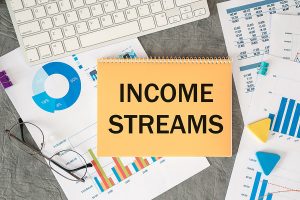
By the time you reach this step, things should be very clear to you.
- You know what your income is
- You know what your expenses are
- You have taken the time to cut expenses you don’t need and paid down your bad debt
- You have created an emergency fund and have enough to survive for 4-6 months without a job or income
- You have started to put your money into investments that will generate interest
The knowledge you now have to continue on your journey is invaluable. The only problem here is going to be time and generating enough money to invest to be financially free. This is dependent on where you are in your life and what your goal is for monthly cashflow that you need to live on today and in retirement.
In my previous steps, we discussed the difference between net worth and passive income and cashflow. The net worth number means nothing if you don’t have enough passive income to pay all of your bills now and then also in the future when inflation increases, housing costs increase, healthcare costs increase and so on. To be honest, your net worth number is cool, but having enough passive income to pay your bills is far better.
HOW MUCH DO YOU NEED TO REACH YOUR GOAL?
This is where you need to figure out and determine what your investment needs to be to reach your goal. In the last Step, I gave you an example of a couple that was able to put away $1,000 per month for 10 years and generated a total amount of about $172,000. Now, let’s assume that couple started at age 50 and now they are 60 and considering retirement. If they kept that $172,000 in the real estate account generating 7% interest and got paid every 3 months, they would receive $1,003 per month or $3,012 every quarter. This was a couple that had $10,000 in expenses every month. Assuming they didn’t take the principal out of the investment (the $172,000), they would not be able to live on this amount.
I have been using an example of 7% interest as an example, but most experts will tell you that in retirement, you will have your money in far safer investments that most likely generate closer to 4% interest. That’s even worse for the 60 year old couple because it means their $172,000 is only generating $573/month.
I know this sounds depressing, but I am hoping that most of the people reading this blog are not in their 50s and who are just trying to start saving now. The most important thing you have in investing and being financially free is time. You really can’t wait any longer. That said, if the 50 year old couple was making $120,000 a year in after tax income and was able to cut their expenses down to $3,000 per month, here is one more example:
- $1,000 rent
- $750 food
- $300 shopping
- $100 gas/car expenses
- $500 entertainment
- $0 credit card payments
- Total: $2,650
The couple’s kids have moved out and are on their own and they have downsized their living expenses and currently need $2,650/month. This is a far cry from $10,000. I am going to assume that couple has $50,000 in savings. That couple making $10,000 per month now puts aside $7,000 per month. So, starting with $50,000 and $7,000 per month over 10 years at an average rate of 7% interest compounded annually, the couple would have $1.34 MILLION in investments. Wow. If that couple keeps the principal investment in an interest account in very conservative investments that generate 4% interest per year, that would be $55,650/year or $4637/month. Add in some money from social security and this couple would be generating about $5,000/month with their $2,650 in living expenses.
As bad as your situation might be, with DEDICATION, FOCUS and a GOAL, you can reach a point where you will be financially secure.
MORE EXAMPLES BY AGE
My biggest regret is that I didn’t save much of any money I earned from my 20s through my mid 30s. If I had some online tools that tracked my net worth and I could see what I was spending, I would have saved more and probably been on a house on the beach by now. The good news is that I did start in my 30s and started to understand that I had to change my habits.
Depending on what age you are and when you want to retire will determine how much you need to save to reach your goal and how much you need to invest on a monthly basis in passive income investments. Obviously, the closer you get to retirement and the less you have saved, the harder it’s going to be to save enough.
Start Saving Immediately – In Your 20s
If you are in your 20s and you’re reading this and you have no wife or kids, now is the best time to start your journey. Figure out your expenses and your income and start saving. You hopefully have a job or some sort of income. If you put aside $300/month for 45 years at 6% interest (as an example), you would have $1,031,000. If you save $400/month, you would have $1.37 million. It’s basically $200 for each check.
Saving in Your 30s
As time grows shorter, you have less time to save which means to hit your goals, you would need to save more. In your 30s, you should have a career path and been in a job long enough that you can save more toward your goals. If you save $500/month for 35 years, you would have $830,000 assuming a 7% annual interest. If you save $600/month, you would have $996,000 and if you save $700/month you would have $1.16 million.
Did you notice something about these two examples? The 20 year old saving HALF US MUCH as the 30 year old was able to save more over the additional 10 years than the 30 year old saving twice as much with 10 less years.
This is power of compound interest!
You might be asking yourself.. well, how much are you saving? Meaning me. My wife has an amazing job and makes $100,000/year. We have maxed out every one of her tax free deductions (more about this later). She has a 401(k) where money is deducted each paycheck and none of it is taxed. It goes into an investment fund and the money grows tax free until we decide to pull it out of the fund which can’t be accessed until after age 59. The best part is that her employer matches up to 3% of her donation. So, she gets free money from her company on top of the money she puts into the retirement account and none of the money is taxed until it’s withdrawn. The max donation any individual can make to a 401(k) is $18,000 per year.
For me personally, I have a company that is organized as an S Corporation. This allows me to have a retirement called a SEP IRA where the company can put money into a retirement account for me. I am allowed to donate up to $54,000 per year to put into a tax-free retirement account. I currently put aside about $2,000 per month that is automatically withdrawn from my business account to the tax free investment account. So, between my wife and I, we are putting aside over $4,000 per month (when you factor in her company’s match) automatically. I don’t see the money as it’s just withdrawn each month.
When my wife and I married about 7 years ago (2nd wife btw), she had no retirement savings and I had about $20,000. Over the past 7 years with maxing out her retirement accounts and deducting money for my SEP IRA with the investments growing, we were able to save about $350,000. Between the two of us, we started basically at age 40 with $20,000 and now are on our way to greater wealth. If we had both saved earlier, we wouldn’t have to put so much money aside now, but the point to this entire blog is that it’s never too late to get started.






